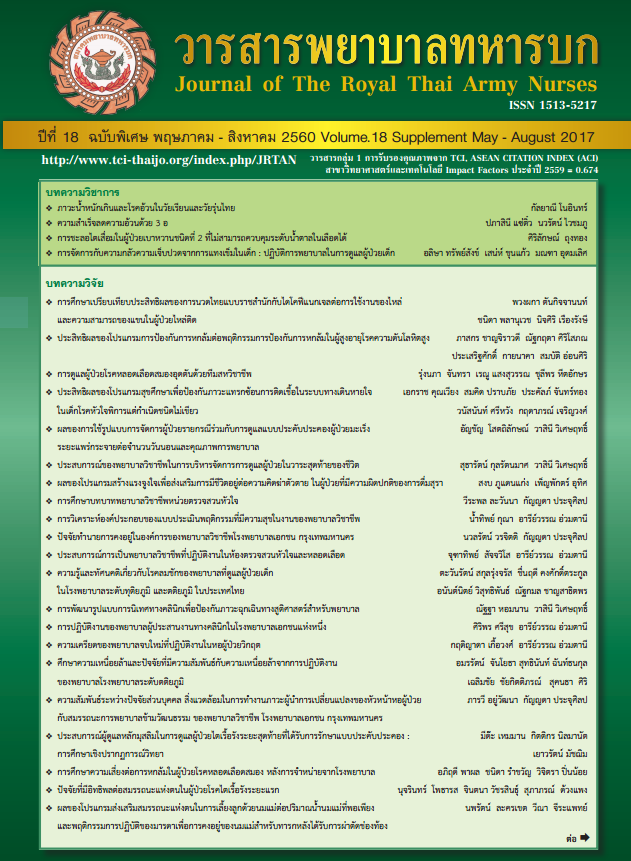การพัฒนารูปแบบการนิเทศทางคลินิกเพื่อป้องกันภาวะฉุกเฉินทางสูติศาสตร์สำหรับพยาบาล
Keywords:
การพัฒนารูปแบบ, การนิเทศทางคลินิก, ภาวะฉุกเฉินทางสูติศาสตร์, The development of model, Clinical supervision, Emergency of ObstetricAbstract
การวิจัยนี้มีวัตถุประสงค์เพื่อพัฒนารูปแบบการนิเทศทางคลินิกเพื่อป้องกันภาวะฉุกเฉินทางสูติศาสตร์สำหรับพยาบาลโดยใช้กระบวนการวิจัยปฏิบัติการแบบมีส่วนร่วม ผู้ร่วมวิจัยคือพยาบาลจำนวน 24 คนใช้วิธีการคัดเลือกแบบกำหนดคุณสมบัติเก็บรวบรวมข้อมูลโดยการสัมภาษณ์เจาะลึก การสนทนากลุ่มและการสังเกต การดำเนินการวิจัยแบ่งออกเป็น 3 ระยะคือ 1) ระยะวิเคราะห์สถานการณ์รูปแบบการนิเทศทางการพยาบาล 2) ระยะร่วมกันพัฒนารูปแบบการนิเทศทางคลินิก 3) ระยะประเมินผลรวมระยะเวลาที่ศึกษา 4 เดือน วิเคราะห์ข้อมูลโดยการวิเคราะห์เชิงเนื้อหาผลการวิจัยพบว่าระยะที่ 1 มีข้อจำกัดเรื่องการสื่อสารด้านนโยบายไม่ทั่วถึงพยาบาลทุกระดับ, การเตรียมความพร้อมเป็นพยาบาลผู้นิเทศทางคลินิกไม่เพียงพอและขาดแนวทางการปฏิบัติและคู่มือการนิเทศที่พยาบาลมีส่วนร่วมพัฒนาขึ้น ระยะที่ 2 ร่วมกันพัฒนารูปแบบการนิเทศทางคลินิกมีการวางแผน, ปรับทัศนคติ ทำความเข้าใจและสร้างข้อตกลงร่วมกัน, แลกเปลี่ยนเรียนรู้จากผู้มีประสบการณ์, ร่วมกันสร้างคู่มือการนิเทศและนำไปทดลองใช้ ระยะที่ 3 ประเมินผลความพึงพอใจและทัศนคติของพยาบาลความเหมาะสมของเนื้อหาคู่มือแนวทางการปฏิบัติ ความยั่งยืนและสม่ำเสมอของการนิเทศทางคลินิก จากการนำรูปแบบการนิเทศที่พัฒนาขึ้นไปทดลองใช้พบว่าพยาบาลมีความพึงพอใจและมีทัศนคติที่ดีขึ้นต่อการนิเทศทางคลินิก
The Development Of Preventive Emergency Obstetric Clinical Supervision Model For Nurses
The qualitative research design aimed at developing a clinical supervision model to prevent obstetrical emergencies for nurses by employing participatory action research. The total subjects were 24 nurses selecting by criterion sampling. Data were collected by conducting in-depth interviews, group discussions, and observations. The study was divided into the following 3 stages: 1) situational analysis of nursing supervision models; 2) development of the clinical supervision model together and 3) performance assessment. The study was conducted over a period of 4 months and the data analysis method applied was content analysis. According to the research findings, In the first stage, the limitation were dissemination and communications concerning clinical supervision policy fail to cover nurses at every level, preparations for becoming nurse supervisors remain inadequate and participation of nurses in the development of supervision models is insufficient. The second stage, planning the development of the supervision model, adjustment of attitudes, understanding and creation of mutual agreements, exchanges of lessons learned from expert with experiences and creation of a practice guideline on clinical supervision and trial implementation. The third stage, assess of the satisfaction and attitudes of nurses, the sustainability of the content in the handbook on practice guideline, the sustainability and regularity of clinical supervision. Based on the trial implementation of the model developed, nurses were found to have satisfaction and good attitudes about clinical supervision.
Downloads
Downloads
How to Cite
Issue
Section
License
บทความหรือข้อคิดเห็นใดใดที่ปรากฏในวารสารพยาบาลทหารบกเป็นวรรณกรรมของผู้เขียน ซึ่งบรรณาธิการหรือสมาคมพยาบาลทหารบก ไม่จำเป็นต้องเห็นด้วย
บทความที่ได้รับการตีพิมพ์เป็นลิขสิทธิ์ของวารสารพยาบาลทหารบก
The ideas and opinions expressed in the Journal of The Royal Thai Army Nurses are those of the authors and not necessarily those
of the editor or Royal Thai Army Nurses Association.






